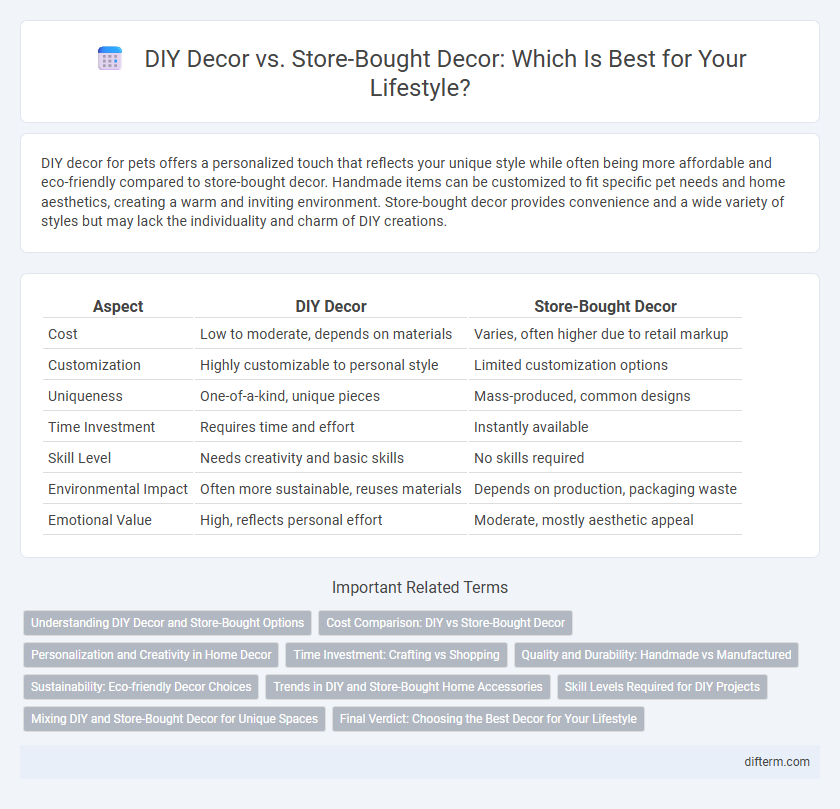DIY decor for pets offers a personalized touch that reflects your unique style while often being more affordable and eco-friendly compared to store-bought decor. Handmade items can be customized to fit specific pet needs and home aesthetics, creating a warm and inviting environment. Store-bought decor provides convenience and a wide variety of styles but may lack the individuality and charm of DIY creations.
Table of Comparison
| Aspect | DIY Decor | Store-Bought Decor |
|---|---|---|
| Cost | Low to moderate, depends on materials | Varies, often higher due to retail markup |
| Customization | Highly customizable to personal style | Limited customization options |
| Uniqueness | One-of-a-kind, unique pieces | Mass-produced, common designs |
| Time Investment | Requires time and effort | Instantly available |
| Skill Level | Needs creativity and basic skills | No skills required |
| Environmental Impact | Often more sustainable, reuses materials | Depends on production, packaging waste |
| Emotional Value | High, reflects personal effort | Moderate, mostly aesthetic appeal |
Understanding DIY Decor and Store-Bought Options
DIY decor allows for personalized creativity and customization, enabling individuals to tailor designs to their unique taste and space requirements. Store-bought decor offers convenience, consistent quality, and a wide variety of styles from trusted brands like Pottery Barn and IKEA. Comparing cost-effectiveness, DIY projects often require time investment and materials, whereas store-bought options provide immediate availability and professional craftsmanship.
Cost Comparison: DIY vs Store-Bought Decor
DIY decor often presents significant cost savings compared to store-bought alternatives, with materials typically costing 30-70% less. Store-bought decor includes retail markups and brand premiums, pushing prices higher, especially for trendy or designer pieces. By repurposing household items or sourcing inexpensive materials, DIY projects minimize expenses while providing personalized and unique interior accents.
Personalization and Creativity in Home Decor
DIY decor offers unparalleled personalization and creativity by allowing individuals to tailor designs, colors, and materials to their unique tastes and home aesthetics. Store-bought decor often lacks the distinctiveness and personal touch that handcrafted items provide, resulting in more generic styles. Embracing DIY projects enhances self-expression and creates meaningful, one-of-a-kind pieces that elevate the overall ambiance of living spaces.
Time Investment: Crafting vs Shopping
Crafting DIY decor demands a significant time investment for planning, sourcing materials, and hands-on creation, often resulting in personalized and unique pieces. In contrast, store-bought decor offers immediate accessibility, saving hours otherwise spent on design and assembly. Time efficiency in shopping appeals to those with busy lifestyles, while DIY enthusiasts prioritize creativity and customization despite the longer commitment.
Quality and Durability: Handmade vs Manufactured
Handmade DIY decor often features superior quality due to meticulous craftsmanship and the use of unique, durable materials tailored to specific design preferences. Manufactured store-bought decor may offer consistency and cost-effective production but can lack the personalized durability and attention to detail found in handmade pieces. Longevity in decor is frequently enhanced by the artisanal techniques and robust materials used in DIY projects, making them potentially more resilient over time.
Sustainability: Eco-friendly Decor Choices
DIY decor often uses upcycled or natural materials, reducing waste and the carbon footprint associated with mass production and shipping of store-bought decor. Choosing locally sourced, biodegradable components for DIY projects supports sustainable living by minimizing environmental impact and promoting a circular economy. Store-bought decor frequently involves synthetic materials and packaging that contribute to landfill waste, making eco-friendly DIY options a more sustainable choice for environmentally conscious consumers.
Trends in DIY and Store-Bought Home Accessories
DIY decor trends highlight personalized, sustainable materials and upcycled elements, appealing to eco-conscious consumers seeking unique, handcrafted home accessories. Store-bought decor increasingly features minimalist designs, smart technology integration, and affordable luxury, catering to convenience and modern aesthetics. Both approaches reflect a growing demand for customization and eco-friendly options in contemporary home styling.
Skill Levels Required for DIY Projects
DIY decor projects demand a range of skill levels, from basic crafting abilities for simple wall art to advanced techniques required for furniture restoration or intricate home accents. Store-bought decor offers a convenient solution without the need for specialized skills, allowing instant aesthetic enhancement. Understanding personal skill levels ensures successful DIY outcomes and prevents costly mistakes or frustration during home embellishment.
Mixing DIY and Store-Bought Decor for Unique Spaces
Combining DIY decor with store-bought pieces creates personalized and dynamic living spaces that reflect individual style and creativity. Handmade items add texture and character, while store-bought decor provides convenience and polished finishes, resulting in a balanced and cohesive aesthetic. This blend allows for budget-friendly customization and continuous evolution of home interiors, enhancing both comfort and uniqueness.
Final Verdict: Choosing the Best Decor for Your Lifestyle
DIY decor offers personalized creativity and cost-effective customization tailored to individual tastes, while store-bought decor provides convenience, consistency, and professional quality. Evaluating factors such as available time, budget, and desired uniqueness helps determine the optimal choice for your lifestyle. The best decor reflects your personality and meets practical needs without compromising style or comfort.
DIY decor vs store-bought decor Infographic

 difterm.com
difterm.com